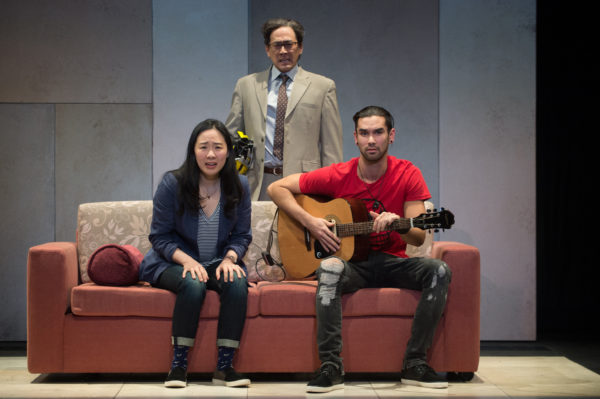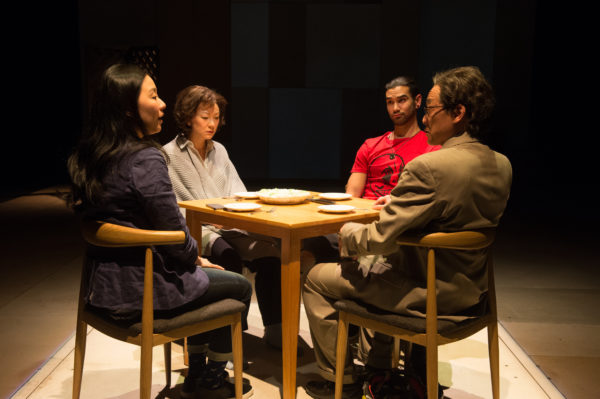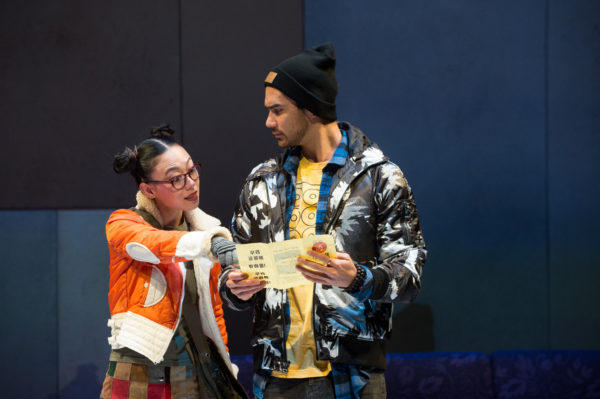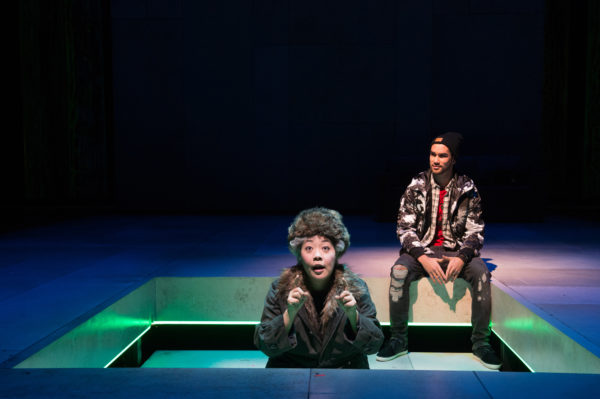
The catch-all umbrella term “Asian American plays” is both rather nebulous and ambiguous, as Asian American cultures and communities are all incredibly diverse and distinct. Nevertheless, this casual grouping — dare I say genre — of plays are typically written by an Asian American-identifying playwright and often have strong thematic similarities and hallmarks no matter the material. It’s a difficult claim to make in many ways, in part because of the varied material and themes, and because some plays are set entirely in Asia, some entirely in the US and some a mix of everything — which isn’t to say that the experience and content don’t reflect the experiences of an Asian American playwright. There’s no firm distinction between an “Asian American play” and a “non-Asian American play”; it’s more of a way to unify playwrights and plays that are similar in content rather than exclude them.
Concepts and themes of identity, belonging, self, intergenerational miscommunication, Westernization and the clash or melding of Asian American values are many times shown through varied states of consciousness — dream sequences, realities blending together, some sort of magical realism, mysticism and mythology, breaking the fourth wall, incomplete conclusions, a tasteful mix of comedy and drama, symbolic representations of thoughts and minimalist design — to name a few. This isn’t to say there aren’t plays without any of this — there are plenty of other identifying factors that come up in many Asian American plays and many plays do not have any or all of these theatrical devices.
I mention this as a framework for Jiehae Park’s literary masterpiece “Hannah and the Dread Gazebo,” directed by Chay Yew at the Oregon Shakespeare Festival. Like Mia Chung’s “You for Me for You,” “Hannah” is a play by a Korean American playwright and contains many representational similarities (minimal set design, magical realism and dream-like states), but its thematic content is different from Chung’s work. Set in both New York City and South Korea before the death of North Korean supreme leader Kim Jong-il in 2011 (if you didn’t read the program before watching and had trouble temporally orienting yourself, Park cleverly sneaks in a mention of an iPhone 4S, which, as a reference, came out in late 2011), the eponymous 34-year-old Hannah (Cindy Im) must navigate the troubled waters of the suicide of her grandmother. Hannah’s path conflicts with her family as well as the North Korean government, as her grandmother committed suicide by jumping off a roof and conveniently into the DMZ between North and South Korea.

Hannah, about to become a board-certified pediatric neurologist, must deal with receiving a mysterious package from the aforementioned recently-deceased grandmother, who wrote a suicide note in Korean (growing up in America and not having entirely learned Korean, Hannah can only partially understand the letter) and sent Hannah a strange object: a salt-shaker with a small rock in it — described by Hannah as “a wish.” This is very derailing to the control freak Hannah, who, as Im plays her, is confident and strong in her words, sure of what she’s saying but quickly has many layers that peel back as soon as she’s out of her comfort zone when her family travels to Korea to get matters sorted out. Academically- and pragmatically- driven, Hannah recognizes how much schooling she had to go through to get to this point in her life, but something inside her questions the logic of the situation (“But sometimes logic is bullshit.”) which in a sense drives her curiosity for understanding her Korean-ness.
My strongest impression of this production is how nuanced of an approach Park uses in order to balance comedy with extremely heavy themes, oftentimes as recurring gags (the characters’ deep obsession with a trellis as an “outside-outside wall” rather than an “inside-outside wall” humorously comes to mind). Immediately in the first scene, it’s clear that Mother (Amy Kim Waschke) is suffering from some sort of very strong, deep depression. Park very cleverly lures the audience in with the temptation of a highly comedic scene as Mother talks on the phone, laughing and talking about gardening and HGTV (You know that show in America called ‘Curb Appeal’? I love that show!”), but immediately turning it around (“Of course when you live in a high-rise you don’t have a curb, so you cannot have curb appeal. And people cannot drive by your house, unless they know how to drive in the SKY! Hahahaha! That is very sad. I am sad. I want to die.”). Waschke’s portrayal of Hannah’s mother, troubled over her mother’s death, is staggeringly real — as the family sits in silence at the dinner table, the discomfort that hangs over the group is accentuated by the acknowledgement of Mother’s instability. Even if Hannah is in fact the protagonist, Mother herself goes through a journey and experiences a very disconcerting dream sequence involving a dismembered cartoon bunny and a happy but confused Kim Jong-il after his death. Eventually crawling out of a symbolic tunnel, I only found the meaning of Mother’s journey myself when I put the many pieces together weeks later — meeting the newly-deceased Kim Jong-il in a dream but pulling herself together to climb out of the hole — her depression may have not gone completely, but it was her way to reconcile and push through.
Every major character in “Hannah” also goes through some sort of unique character arc — whether that arc is complete or where this lies is up to the audience. Hannah’s brother Dang (Sean Jones) goes on a journey of his own — his discovery of this Korean myth about a tiger and a bear (if we’re drawing connections, Jessica Huang’s “Purple Cloud” also has a pivotal myth element) is just the beginning of his discovery. Dang and Girl (Eunice Hong) have a sort of undeniable chemistry, with Dang as an oblivious but good-hearted 22-year-old American kid who happens to be Korean American, while Girl acts as a sort of strong-willed counterpart. Dang’s journey instead culminates in staying in Korea with Girl — having just graduated from college, he hasn’t quite found himself.

Jessica Ko takes on many roles as the Shapeshifter, which serves to fuel that sort of magical feel of the play. The Shapeshifter can dually be interpreted as one actor playing many roles or a very purposeful insertion and manipulation of reality by an outside force, or simply that the story happened in the way that it did due to the Shapeshifter’s presence. It’s a fascinating question that’s never truly answered, but Ko plays the part beautifully — from the sassy retirement home receptionist to Kim Jong-il, Ko transforms swiftly from one to another, contributing such comedic grace to each role that I quickly forgot that one actor was playing every single role.
Another interesting element of “Hannah” is the inclusion of scenes entirely or almost entirely spoken in a different language. Father (Paul Juhn) has lengthy conversations in Korean with a government official (also played by Jessica Ko), which are never interpreted for the audience (who, by the looks of the OSF audiences, probably don’t know Korean for the most part). It’s quickly clear what they’re talking about — which is often very difficult to portray — and the urgency in the characters’ words apparent, but even the inclusion of a foreign language in a play at such a high-profile festival is exciting, supporting the normalization and encouragement of multicultural, bilingual families as well as the acknowledgment that us as viewers and as humans are not always privy to the entire conversation (for those in the audience who understand Korean, they may be, and that’s also a perfectly acceptable theater experience).
It’s up to the viewer to interpret many pieces of the play, and I would argue that the conclusion is very purposefully vague and even absent because life doesn’t have clean endings like that. Hannah spends much of the play talking about (and getting criticized for) having such a stiff approach and controlling attitude towards life — to Hannah, everything must have a beginning, middle and end. Without a thorough end to the play, the production simply pinches and squeezes that feeling of discomfort and acknowledgment that there really may not be an end. It’s not a cliffhanger and it’s not a lack of an end — it perches in this gray area that leaves viewers gulping for their last breath and never giving it to them — and that’s what makes it so powerful.

In terms of production values, I was personally most astounded by the incredible combination of scenic design by Collete Pollard, lighting design by David Weiner and sound design by Obadiah Eaves. Props falling from the ceiling, parts of scenes isolated by small “ding” sounds and spotlights were only the tip of the iceberg — the most spectacular yet still very simple theatrical effect involved Dang and Hannah standing on the roof of a high rise, gripping the salt-shaker with the stone. As Hannah, in a fit of uncharacteristic rage, throws her grandmother’s prized possession over the side of the building, small whooshing sounds and the sounds of a bird catching it combined with lighting and the height of the set gives the illusion of the object actually being thrown and caught even if the salt-shaker never left the actors’ hands. It’s such a magical moment that involves the talents of many designers that only lasts an instant, but leaves an impression for a lifetime.
Even after all of this, I don’t know if I’ll ever be done processing and digesting “Hannah and the Dread Gazebo.” As an Asian American, I always feel that plays like these always hit me incredibly hard. Themes of mental illness, family death, displacement, belonging and academic pressure are close to home. Nevertheless, other less heavy elements of this play (and other Asian American plays) provide a sort of attraction to me and others. In the first scene, Father (Paul Juhn) interrogates Hannah about her lifestyle (“Are you eating? Are you exercising? Are you ever getting married? Well, make sure you get some exercise. Health is everything.”), to which I laughed so hard I started crying because Juhn’s portrayal was so uncannily similar to what my own Taiwanese American mother asks of me while I talk with her on the phone. Small comedic moments like this also greatly appeal to young Asian American audiences because they can relate, which is encouraging to see as burgeoning young Asian American artists find more and more material that they may personally connect to.
Seeing a play like “Hannah” is incredibly rewarding but also incredibly emotional — no matter if one’s experiences directly mirror or simply are a casual reflection of plays like these, they’re so powerful and indescribably beautiful. “Hannah” is no exception — Jiehae Park’s cryptic masterpiece is a must-see for audiences willing to challenge themselves and step out of their comfort zones.
“Hannah and the Dread Gazebo” is playing at the Oregon Shakespeare Festival’s Thomas Theatre in Ashland, Oregon, until October 28.
Contact Olivia Popp at oliviapopp ‘at’ stanford.edu.
